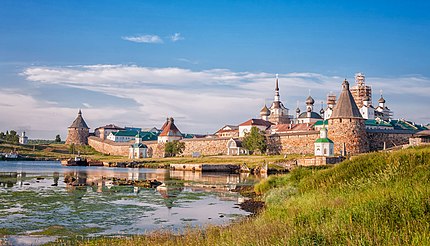Talk:Solovetsky Monastery
| This article is rated Start-class on Wikipedia's content assessment scale. It is of interest to the following WikiProjects: | ||||||||||||||||||||||||||||||||||||||||||||||||||||||||||||||||||||||||||||||||||||
| ||||||||||||||||||||||||||||||||||||||||||||||||||||||||||||||||||||||||||||||||||||
Untitled
[edit]To Ghirlandajo : It's not the same tower, they are different. I was there and see them. May be I'll shot the first one if I will be there again.
"Please explain your problems on the discussion page"
[edit]The above was the note to me when the following was reverted, the 2nd half (on the GULAG) was my contribution.
"Solovetsky Monastery (Соловецкий монастырь in Russian), was the greatest citadel of Christianity in the Russian North, and was then turned into a special Soviet prison and labor camp, from 1926-1939 which served as a prototype for the GULAG system."
The statement on the GULAG is factual. I've been inside the Monastery buildings myself and seen evidence (at least in the form of a one room museum type display) of this. Solzhenitsin writes about it in the "Gulag Archpeligo" and I've seen references or excerpts on this from Gorky, newspaper articles, etc.
So, I guess my only problem is that I'd like the facts included, and that this being the birthplace of the GULAG, that this fact is important enough to be put up front.
A couple minor things: 1) "has been" instead of "was" looks too much like a Soviet translation 2) There are seperate articles on "Solovki" "Solovetsky Islands" and "Solovetsky Monastery." I'm not suggesting that right now that we merge these, but it might be proper to consider what should go where. 3) I'm trying to figure out what's the problem with putting a mention of the GULAG upfront.
So I'll put my half sentence back in and await an answer. Smallbones 13:41, 10 April 2006 (UTC)
Solovetski Monastery / Solovetskin Luostari
[edit]To Ghirlandajo. Just for your notice. The attacks against the Solovetski Monastery in 1571, 1582, and 1611 were carried out by the Finns, not Swedes and Livonian Brothers of the Sword. Please correct this in your main article.
According to Finnish documented historical sources these Kainuun Rappasodat resulted fighting between the Finnish tribes Karelians and Kainus living on the coast of Kainuunmeri (Gulf of Bothnia) agitated by the Monks of Solovetski Monastery and supported by Muscovite Grand Prince. (Tsar) Ivan the Terrible (Ivan the Cruel). This period 1570 - 1595 is also known as "Vanhan vihan sota (Old Hate War)". The worstest agitator seems to have been Karelian tribal chief Miihakki, who in fact was a monk Mihail from Solovetski Monastery. It was only after his death in trap in 1593 these battles ended to the Peace Treaty of Täyssinä in 1595. Other "Russian" commanders were Propotshkin from Pähkinälinna (Schlisselburg) on Neva neck, Pajar (Bojar) Andrei Oboljanov from "Äänisen takainen Karjala" (Kargopol) and Karelian Kirila Rogosin from Käkisalmi. Kirila Rogosin´s brother was killed in Roukkula village in 1586 by Finns from Käkisalmi fortress.
The wooden monastery (which was burned by the Kainus in 1571) was rebuilt in 1584 - 1596 from stone with high wall which prevented the attack in 1611. According to old Karelian legend the monks deported all women from Salosaari (Solokka Island), not to lead the monks for desire after womans flesh.
JN
Fire 1923
[edit]I remember from my visit to the monastery that there was a major fire in 1923. The interiors of the monastery were sadly destroyed, the fire leaving not much more than the thick stone walls. I think this should be included in the article if it can be confirmed.
—Preceding unsigned comment added by 193.11.8.190 (talk) 15:18, 15 October 2008 (UTC)
File:Историко-культурный комплекс Соловецких островов.jpg to appear as POTD
[edit]Hello! This is a note to let the editors of this article know that File:Историко-культурный комплекс Соловецких островов.jpg will be appearing as picture of the day on September 6, 2015. You can view and edit the POTD blurb at Template:POTD/2015-09-06. If this article needs any attention or maintenance, it would be preferable if that could be done before its appearance on the Main Page. Thanks! — Chris Woodrich (talk) 00:03, 20 August 2015 (UTC)
- Start-Class Russia articles
- Top-importance Russia articles
- Top-importance Start-Class Russia articles
- Start-Class Russia (technology and engineering) articles
- Technology and engineering in Russia task force articles
- Start-Class Russia (visual arts) articles
- Visual arts in Russia task force articles
- Start-Class Russia (history) articles
- History of Russia task force articles
- Start-Class Russian, Soviet and CIS military history articles
- Russian, Soviet and CIS military history task force articles
- Start-Class Russia (religion) articles
- Religion in Russia task force articles
- WikiProject Russia articles
- Start-Class Eastern Orthodoxy articles
- Unknown-importance Eastern Orthodoxy articles
- Start-Class Christianity articles
- WikiProject Eastern Orthodoxy articles
- Start-Class Historic sites articles
- Unknown-importance Historic sites articles
- WikiProject Historic sites articles
- Start-Class military history articles
- Start-Class fortifications articles
- Fortifications task force articles













